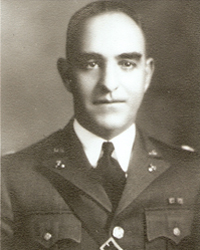Major
Allen F. Grum
 Allen Frederick Grum graduated
from the Virginia Polytechnic Institute in 1916 with a degree in Electrical Engineering. As the country mobilized
for World War I, Grum entered the Army as a Second Lieutenant and was assigned to the Coast Artillery Corps. Grum
deployed to France and participated in three campaigns. After the war he applied for a branch transfer to
Ordnance. This was disapproved, but in 1920 he was assigned to Aberdeen Proving Ground as a student officer. He
was then assigned to Watertown Arsenal, Massachusetts, and from there to the Ordnance School of Applications at
Raritan Arsenal, New Jersey. He attended a 1921 summer session at MIT enrolling in a course in Electrical Power
and a course in Machine Tool Work.
Allen Frederick Grum graduated
from the Virginia Polytechnic Institute in 1916 with a degree in Electrical Engineering. As the country mobilized
for World War I, Grum entered the Army as a Second Lieutenant and was assigned to the Coast Artillery Corps. Grum
deployed to France and participated in three campaigns. After the war he applied for a branch transfer to
Ordnance. This was disapproved, but in 1920 he was assigned to Aberdeen Proving Ground as a student officer. He
was then assigned to Watertown Arsenal, Massachusetts, and from there to the Ordnance School of Applications at
Raritan Arsenal, New Jersey. He attended a 1921 summer session at MIT enrolling in a course in Electrical Power
and a course in Machine Tool Work.
His desire to become a contributing member of the Ordnance Department was finally realized in 1922 when the Senate approved his branch transfer. His first assignment was to Savanna Proving Ground, IL. The proving ground was a test area for 75mm and 155mm howitzers. Grum's wartime service and careful Ordnance training allowed him to be a contributing officer to the repair and storage of equipment returning from overseas. He received his first Ordnance command in 1923 as the Commanding Officer of the 34th Ordnance Company at Fort Bragg, NC. Grum's wartime service and his considerable Ordnance training enabled him to pass on his experiences and lessons learned to his junior officers and enlisted soldiers.
In 1924 Grum left Fort Bragg to join the Ordnance Department Specialist School at Raritan Arsenal, NJ. He departed Raritan in 1926 to become the Assistant to the Ordnance Officer, VIII Corps Area in San Antonio, TX. His position required him to travel extensively throughout the Southwest United States visiting active, Reserve and National Guard units.
He was next assigned to the Militia Bureau in 1928. His two year experience in the Corps area made him a valuable member of the Ordnance Department Technical Committee, one who could provide accurate information on the status of Reserve and National Guard Ordnance units. He was selected in 1933 to attend the Army Industrial College. On graduation in 1934 he was given a Mobilization Assignment in the Office of the Assistant Secretary of War. This was a singular assignment as this office was responsible for the supervision of all of the Army's procurement and mobilization for war time.
At the same time he was also ordered to Rock Island Arsenal as the Assistant Chief of Manufacturing. During his tenure over 300 light tanks and combat cars were completed. Grum was promoted to Maj. on 1 July 1937. Unfortunately he suffered a cerebral hemorrhage on 26 July 1937. He spent several weeks at Walter Reed Hospital and returned to his post at Rock Island. His commander reported that his illness had caused no loss in effectiveness, and Grum continued his supervisory role. In spite of this report, supporting letters from cohorts, and a strong letter from MAJ Grum, himself, a medical board deemed him physically unfit for further duty. He was medically retired from the Army on 31 December 1938.
Grum's Ordnance career was at a time between two wars. It was at a time when the Ordnance Department officer corps was small, at times less than 275 officers. His return to Rock Island following his hospitalization and his determination to remain on active duty are solid examples of dedication that served to inspire those that knew him. In many respects his career is "what might have been." Clearly without his illness he would have been a central figure in the Ordnance Corps during World War II.